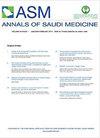评论:科威特国家乳房x光检查项目:科威特妇女5年筛查的结果
IF 1.8
4区 医学
Q2 MEDICINE, GENERAL & INTERNAL
引用次数: 0
摘要
我们阅读了你们杂志于2021年10月7日发表的题为“科威特国家乳房x线摄影筛查计划:科威特妇女5年筛查的结果”的研究。我们想要赞扬作者的这篇精心制作和可信的文章。这篇文章提供了大量关于科威特妇女乳腺癌患病率的信息,尽管她们的参与率很低。该研究是一项基于人群的筛查研究,从2014年到2019年,在14773名可能患有乳腺癌的无症状女性中进行。该研究通过全视野数字乳房x线摄影系统确定了551名患有病变的女性。这篇文章确实为科威特妇女乳腺癌的早期发现增加了价值。然而,从被诊断为乳房病变的妇女(n=551)收集更多有关危险因素的信息,将进一步提高对危险因素的理解,并设计有针对性的乳腺癌筛查项目。虽然,作者提到筛查是针对特定年龄组(40-69岁)进行的。已知的唯一可能导致乳腺癌发生的危险因素是肥胖,2月经初潮年龄,3绝经年龄较晚,3先前存在的代谢紊乱,4吸烟习惯,5饮食习惯,6血型,7身体活动水平,6咖啡因摄入,维生素D缺乏,睡眠时间,空气人口,8夜班,糖尿病,7和辐射暴露根据上述风险因素收集的信息将大大有助于了解这些风险因素对乳腺癌发生的独特作用。此外,手稿摘要结果部分的陈述指出,40-49岁年龄组的女性患乳腺癌的比例为23.1%。本文章由计算机程序翻译,如有差异,请以英文原文为准。
Comment on: Kuwait National Mammography Screening Program: outcomes of 5 years of screening in Kuwaiti women
We read the research published in your journal titled “Kuwait National Mammography Screening Program: outcomes of 5 years of screening in Kuwaiti women” on 7 October 2021.1 We would like to commend the authors on such an elaborate and plausible article. The article provides a great deal of information on the prevalence of breast cancer among women in Kuwait despite poor participation. The study was a population-based screening study carried out from 2014-2019 among 14 773 asymptomatic women for possible breast cancer. The study identified 551 women with lesions by a full-field digital mammography system. The article indeed adds value to the early detection of breast cancer in women in Kuwait. However, collecting more information about risk factors from women (n=551) diagnosed with breast lesions would further improve the understanding of contributing risk factors and designing targeted breast cancer screening programs. Although, the authors mentioned that the screening was done for a specific age group (40-69 years old). The known risk factors that can uniquely contribute to the occurrence of breast cancer are obesity,2 age of menarche,3 late age of menopause,3 pre-existing metabolic disorders,4 smoking habit,5 dietary habits,6 blood group,7 level of physical activity,6 consumption of caffeine, vitamin D deficiency, duration of sleep, air population,8 night work, diabetes,7 and radiation exposure.7 Information collected based on the above mentioned risk factors would greatly add to the understanding of the unique contribution of these risk factors to the occurrence of breast cancer. Moreover, the statement in the result section of the abstract of the manuscript states that the percentage of women with breast cancer between the 40-49 year age group was 23.1%.
求助全文
通过发布文献求助,成功后即可免费获取论文全文。
去求助
来源期刊

Annals of Saudi Medicine
医学-医学:内科
CiteScore
2.80
自引率
0.00%
发文量
44
审稿时长
4-8 weeks
期刊介绍:
The Annals of Saudi Medicine (ASM) is published bimonthly by King Faisal Specialist Hospital and Research Centre, Riyadh, Saudi Arabia. We publish scientific reports of clinical interest in English. All submissions are subject to peer review by the editorial board and by reviewers in appropriate specialties. The journal will consider for publication manuscripts from any part of the world, but particularly reports that would be of interest to readers in the Middle East or other parts of Asia and Africa. Please go to the Author Resource Center for additional information.
 求助内容:
求助内容: 应助结果提醒方式:
应助结果提醒方式:


